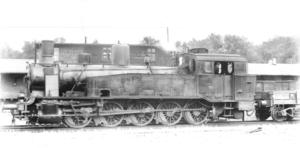WLE 0101-0105
| WLE 0101-0105 | |
|---|---|
|
historical recording
|
|
| Numbering: | WLE 0101-0105 |
| Number: | 5 |
| Manufacturer: |
Hanomag serial number 4313–4315, 10106–10107 |
| Year of construction (s): | 1904-1922 |
| Retirement: | until 1960 |
| Type : | E n2t |
| Genre : | Gt 55.15 |
| Gauge : | 1435 mm ( standard gauge ) |
| Length over buffers: | 0101-0103: 12,028 mm 0104-0105: 12,140 mm |
| Length: | 0101-0103: 10,728 mm 0104-0105: 10,840 mm |
| Height: | 4,200 mm |
| Width: | 3,100 mm |
| Total wheelbase: | 5,590 mm |
| Smallest bef. Radius: | 100 m |
| Empty mass: | 0101-0103: 50 t 0104-0105: 51 t |
| Service mass: | 0101-0103: 64 t 0104-0105: 65 t |
| Wheel set mass : | up to 13 t |
| Top speed: | 50 km / h |
| Indexed performance : | 419.5 kW (570 hp) |
| Driving wheel diameter: | 1,300 mm |
| Control type : | Heusinger |
| Number of cylinders: | 2 |
| Cylinder diameter: | 520 mm |
| Piston stroke: | 600 mm |
| Boiler overpressure: | 12 bar |
| Grate area: | 2.03 m² |
| Evaporation heating surface: | 115.03 m² |
| Water supply: | 6.2 m³ |
| Fuel supply: | 2.5 t |
| Brake: | Originally vapor barrier and handbrake from 1928. Indirect brake from Knorr |
The standard gauge tank locomotives WLE 0101-0105 the Westphalian Provincial Railroad (WLE) were unpowered axles steam locomotives for freight operations , of which at Hanomag five locomotives were built from 1904 to 1922 as a whole. They were in operation at WLE until 1960 when they were retired and scrapped.
history
Since the trailer loads in freight transport increased sharply from 1900 onwards, the Westphalian State Railroad decided to order three heavy freight train tender locomotives with the E wheel arrangement. The company was the first railway administration to use locomotives with Gölsdorf axles .
The locomotives were able to move a load of 250 t on an incline of 20 ‰ at a speed of 30 km / h. Since the locomotives proved their worth, two more locomotives with almost unchanged parameters were ordered after the First World War . The locomotives were originally called 101 - 105 respectively. In 1951 they were given a four-digit number, preceded by a 0 . The 0101 locomotive was nicknamed Kamp (after the General Director of the Westphalian Union ), the 0102 locomotive was nicknamed Wanne .
Thanks to the axles that could be moved laterally, the locomotives were able to negotiate curved tracks of 100 m without any problems, and they could also negotiate a drainage hill with a radius of 300 m. When the traffic loads on the railway increased significantly in the mid-1930s, the WLE 0121-0123 took over most of the tasks. All locomotives survived the Second World War . With the procurement of diesel locomotives , they became superfluous. In 1955 the first locomotives, the 0101 and 0102, were scrapped, and in 1956 the 0103 disappeared from the tracks. The remaining two locomotives were scrapped in 1960.
construction
The locomotives were two-cylinder locomotives for wet steam . The 0105 was converted to superheated steam in 1936 . From the side view, all locomotives were almost identical, although 18 years of development were between them.
The locomotives had a riveted boiler with a copper fire box , the boiler's steam supply was provided by two live steam jet pumps of different designs with an output of 120 l / min. They had a simple sheet metal frame. The 2nd and 4th axes were firmly mounted in the frame, the remaining axes had a side play of ± 26 mm. In addition, the driving axle is designed as a central axis had 10 mm weakened flanges . The locomotives were equipped with a wheel tire wetting device. The first three locomotives were with slide plates provided the 1922-built 0104 and 0105 had spool .
The original kerosene lighting was replaced by electric lighting with a turbo generator after the Second World War . The sanding was done by hand. The locomotives had two sand downpipes on each side of the engine (in front of the leading axle in each direction of travel) and a sandpit on the top of the boiler for forward travel and a sandpit below the driver's cab for reverse travel. The 0101 locomotive still had this equipment in the mid-1950s, the 0104/0105 were later retrofitted with a second sand dome on the top of the boiler. At first only with the vapor barrier equipped and a hand brake that was 1928/1929 indirect brake of Knorr retrofitted. The compressed air was supplied by a two-stage air pump from Knorr. The locomotives were equipped with a Ramsbotton type safety valve , a Latowski type bell , a visual lubricator and a locomotive whistle.
The locomotives originally had superstructures on the driver's cab, later these were replaced by sliding hatches.
literature
- Friedrich Risse, Günther Krause: The steam locomotives of the WLE . DGEG Medien GmbH, Hövelhof 2006, ISBN 3-937189-25-4 , p. 66-71 .
Web links
Individual evidence
- ↑ Data sheet about the locomotives of the Westfälische Landes-Eisenbahn with mention of the WLE 0101-0105
- ↑ a b c d e Friedrich Risse, Günther Krause: The steam locomotives of the WLE . DGEG Medien GmbH, Hövelhof 2006, ISBN 3-937189-25-4 , p. 66-71 .
